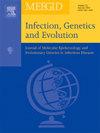耐碳青霉烯鲍曼不动杆菌临床分离株的分子序列分型:全面的全球更新
IF 2.6
4区 医学
Q3 INFECTIOUS DISEASES
引用次数: 0
摘要
抗菌素耐药性(AMR)的出现和传播对全球公共卫生构成了重大挑战。了解细菌种群中抗菌素耐药性的动态对于制定有效的策略来减轻其影响至关重要。克隆谱系,代表遗传相关的细菌群,在塑造抗菌素耐药性传播的景观中起着至关重要的作用。本文综述了不同地理区域耐碳青霉烯鲍曼不动杆菌(螃蟹)临床分离株分子序列分型的最新进展,重点介绍了多位点序列分型(MLST)的应用。螃蟹在卫生保健环境中构成了无声的威胁,成为全球公共卫生问题,由于对碳青霉烯类抗生素(最后一线抗生素)的耐药性,治疗选择有限,导致死亡率增加。这一审查将成为宝贵的资源,提供与螃蟹有关的流行病学数据的深入分析和解释。通过对这些数据的细致检查,卫生保健专业人员将对这种病原体在不同地理区域的传播和流行情况有细致的了解。此外,通过纳入以流行病学见解为依据的循证战略,利益攸关方可以增强其有效对抗这一强大病原体的能力,从而保障公众健康并促进患者获得最佳结果。本文章由计算机程序翻译,如有差异,请以英文原文为准。
Molecular sequence typing of carbapenem-resistant Acinetobacter baumannii clinical isolates: A comprehensive global update
The emergence and spread of antimicrobial resistance (AMR) pose significant challenges to public health worldwide. Understanding the dynamics of AMR within bacterial populations is crucial for devising effective strategies to mitigate its impact. Clonal lineages, representing genetically related group of bacteria, play a vital role in shaping the landscape of AMR dissemination. This review endeavors to provide a comprehensive update on the molecular sequence typing of carbapenem-resistant Acinetobacter baumannii (CRAB) clinical isolates across various geographical regions, with particular emphasis on the application of multilocus sequence typing (MLST). CRAB poses a silent threat in healthcare settings, emerging as a public health concern globally corporate with limited treatment options due to the resistance to carbapenems, the last-line antibiotics, leading to increased mortality rates. This review will serve as invaluable resources, offering in-depth analysis and interpretation of epidemiological data related to CRAB. Through meticulous examination of this data, healthcare professionals will be equipped with a nuanced understanding of the spread and prevalence of this pathogen across diverse geographic regions. Additionally, by incorporating evidence-based strategies informed by epidemiological insights, stakeholders can enhance their ability to effectively combat this formidable pathogen, thereby safeguarding public health and promoting optimal patient outcomes.
求助全文
通过发布文献求助,成功后即可免费获取论文全文。
去求助
来源期刊

Infection Genetics and Evolution
医学-传染病学
CiteScore
8.40
自引率
0.00%
发文量
215
审稿时长
82 days
期刊介绍:
(aka Journal of Molecular Epidemiology and Evolutionary Genetics of Infectious Diseases -- MEEGID)
Infectious diseases constitute one of the main challenges to medical science in the coming century. The impressive development of molecular megatechnologies and of bioinformatics have greatly increased our knowledge of the evolution, transmission and pathogenicity of infectious diseases. Research has shown that host susceptibility to many infectious diseases has a genetic basis. Furthermore, much is now known on the molecular epidemiology, evolution and virulence of pathogenic agents, as well as their resistance to drugs, vaccines, and antibiotics. Equally, research on the genetics of disease vectors has greatly improved our understanding of their systematics, has increased our capacity to identify target populations for control or intervention, and has provided detailed information on the mechanisms of insecticide resistance.
However, the genetics and evolutionary biology of hosts, pathogens and vectors have tended to develop as three separate fields of research. This artificial compartmentalisation is of concern due to our growing appreciation of the strong co-evolutionary interactions among hosts, pathogens and vectors.
Infection, Genetics and Evolution and its companion congress [MEEGID](http://www.meegidconference.com/) (for Molecular Epidemiology and Evolutionary Genetics of Infectious Diseases) are the main forum acting for the cross-fertilization between evolutionary science and biomedical research on infectious diseases.
Infection, Genetics and Evolution is the only journal that welcomes articles dealing with the genetics and evolutionary biology of hosts, pathogens and vectors, and coevolution processes among them in relation to infection and disease manifestation. All infectious models enter the scope of the journal, including pathogens of humans, animals and plants, either parasites, fungi, bacteria, viruses or prions. The journal welcomes articles dealing with genetics, population genetics, genomics, postgenomics, gene expression, evolutionary biology, population dynamics, mathematical modeling and bioinformatics. We also provide many author benefits, such as free PDFs, a liberal copyright policy, special discounts on Elsevier publications and much more. Please click here for more information on our author services .
 求助内容:
求助内容: 应助结果提醒方式:
应助结果提醒方式:


